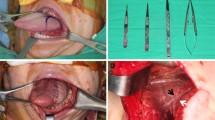Abstract
Background
We performed robot-assisted neck dissection (RAND) via a modified face-lift (MFLA) or retroauricular approach for neck management and carried out free flap reconstruction via these approaches in patients with head and neck cancer. We assessed the feasibility of free flap reconstruction in patients who had undergone transoral resection of a primary lesion and RAND via these approaches.
Methods
In this prospective study, seven patients with head and neck squamous cell carcinoma were enrolled between August 2011 and May 2012. Approval was obtained from the institutional review board of Yonsei University. A radial forearm free flap was used for reconstruction because of its thin structure and pliability. Microvascular anastomosis was performed via an MFLA or retroauricular approach using a microscope and microvascular instrument set.
Results
Pathology reports showed a negative margin in all patients. On the basis of pathologic information for the primary lesion and neck specimens, 5 patients underwent surgery alone and two received adjuvant radiotherapy. At the last outpatient department visit, all patients were alive without locoregional recurrence. All patients were extremely satisfied with the invisible postoperative scar. On average, patients tolerated an oral diet after 1–2 weeks. The status of the free flap was viable and functioning in all patients.
Conclusions
Although long-term follow-up of oncologic safety is required to establish these approaches as valid treatment methods, our study has demonstrated the feasibility of free flap reconstruction and RAND via an MFLA or retroauricular approach.



Similar content being viewed by others
References
Rodrigo JP, Shah JP, Silver CE, et al. Management of the clinically negative neck in early-stage head and neck cancers after transoral resection. Head Neck. 2011;33:1210–9.
Park YM, Lee WJ, Lee JG, et al. Transoral robotic surgery (TORS) in laryngeal and hypopharyngeal cancer. J Laparoendosc Adv Surg Tech A. 2009;19:361–8.
Park YM, Lee JG, Lee WS, Choi EC, Chung SM, Kim SH. Feasibility of transoral lateral oropharyngectomy using a robotic surgical system for tonsillar cancer. Oral Oncol. 2009;45:e62–6.
Park YM, Kim WS, Byeon HK, De Virgilio A, Jung JS, Kim SH. Feasiblity of transoral robotic hypopharyngectomy for early-stage hypopharyngeal carcinoma. Oral Oncol. 2010;46:597–602.
Koh YW, Chung WY, Hong HJ, et al. Robot-assisted selective neck dissection via modified face-lift approach for early oral tongue cancer: a video demonstration. Ann Surg Oncol. 2012;19:1334–5.
Lee HS, Kim WS, Hong HJ, et al. Robot-assisted supraomohyoid neck dissection via a modified face-lift or retroauricular approach in early-stage cN0 squamous cell carcinoma of the oral cavity: a comparative study with conventional technique. Ann Surg Oncol. 2012;19:3871–8.
Terris DJ, Tuffo KM, Fee WE. Modified facelift incision for parotidectomy. J Laryngol Otol. 1994;108:574–8.
Terris DJ, Singer MC, Seybt MW. Robotic facelift thyroidectomy: II. Clinical feasibility and safety. Laryngoscope. 2011;121:1636–41.
Ghanem TA. Transoral robotic-assisted microvascular reconstruction of the oropharynx. Laryngoscope. 2011;121:580–2.
Selber JC. Transoral robotic reconstruction of oropharyngeal defects: a case series. Plast Reconstr Surg. 2010;126:1978–87.
Moore EJ, Olsen KD, Martin EJ. Concurrent neck dissection and transoral robotic surgery. Laryngoscope. 2011;121:541–4.
Acknowledgment
We thank the professional editors who helped prepare the English-language version of this document.
Disclosure
The authors have no funding, financial relationships, or conflict of interest to disclose.
Author information
Authors and Affiliations
Corresponding author
Electronic supplementary material
Below is the link to the electronic supplementary material.
Supplementary material 1 (WMV 133755 kb)
Supplementary material 2 (WMV 12513 kb)
Supplementary material 3 (WMV 76052 kb)
Rights and permissions
About this article
Cite this article
Park, Y.M., Lee, W.J., Yun, I.S. et al. Free Flap Reconstruction After Robot-Assisted Neck Dissection Via a Modified Face-Lift or Retroauricular Approach. Ann Surg Oncol 20, 891–898 (2013). https://doi.org/10.1245/s10434-012-2731-6
Received:
Published:
Issue Date:
DOI: https://doi.org/10.1245/s10434-012-2731-6




